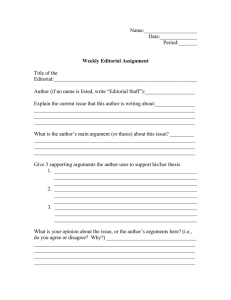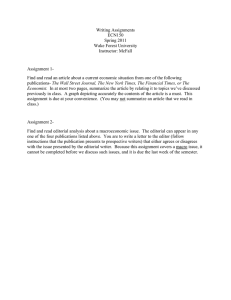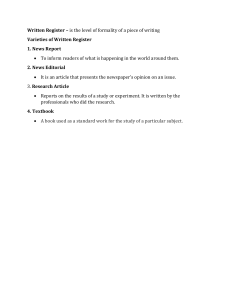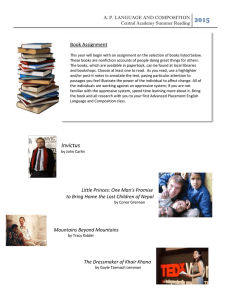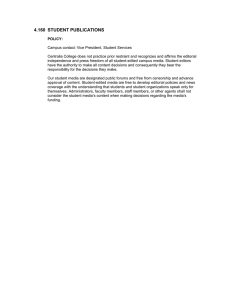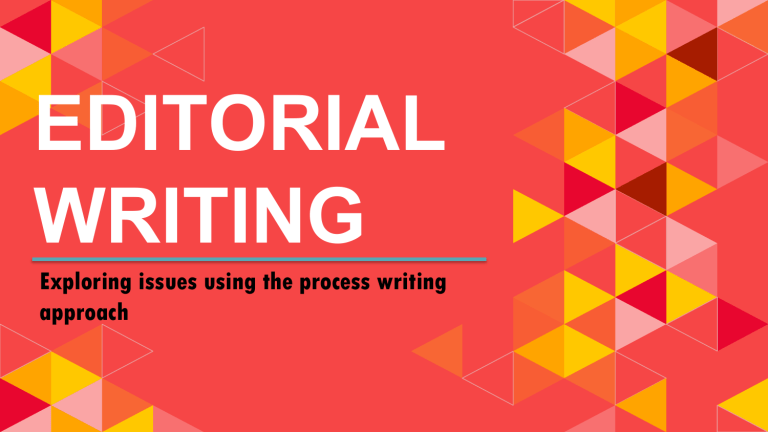
EDITORIAL WRITING Exploring issues using the process writing approach Who are the editorial writers ? The editorial writers are the most intelligent people in the publication. 2 The Editorial Page ◂ ◂ The editorial page of any newspaper is the VOICE of the editorial staff and the readers. It expresses the opinion of whatever the management of the publication feels in relation to the present occasion. 3 Objectives of an Editorial ◂ ◂ To explain and interpret the news, to put it in on its proper perspective, to analyze it, to draw conclusions from that analysis and To persuade the readers to follow a course of action that the newspaper believes is for the public good regardless of party interests involved 4 Functions of an Editorial Writer ◂ ◂ ◂ ◂ Explaining the news Filling the background Forecasting the future Passing moral judgment 5 Principles of Editorial Writing The code of principles emphasizes the scientific method in arriving at and presenting the TRUTH. The editorial writer should present facts honestly and fully. The editorial writer should draw objective conclusions from the stated facts, basing them upon the weight of evidence and upon his considered concept of the greatest good. The editorial writer should never be motivated by personal interest, nor use his influence to seek special favors for himself or for others. The editorial writer should realize that he is not infallible. 7 The editorial writer should regularly review his own conclusions in the light of all obtainable information. The editorial writer should have the courage of wellfounded conviction and democratic philosophy of life. The editorial writer should support his colleagues in their adherence to highest standards of profession integrity. 8 The editorial writer should regularly review his own conclusions in the light of all obtainable information. The editorial writer should have the courage of wellfounded conviction and democratic philosophy of life. The editorial writer should support his colleagues in their adherence to highest standards of profession integrity. 9 Types of Editorial Informative – are those which just give information, review, or announce certain facts or events. Example: The Need for Population Education Poverty, high cost of living, school crisis, lack of job opportunities confront common people. Millions of children are victims of under-nourishment and deficiency diseases that shorten their life and harm their mental development. Due to the failure of parents to send all their children to school, illiteracy rates are high and are still increasing. Many of us have these problems. But very few are aware that excessive population growth is responsible for these pressures as well as for the lowering of the quality of human resources and development, especially as regards educational standards. The inclusion of Population Education in the school curriculum is then the answer to the need of the younger crop who are bound to face the reality of parenthood in the near future. Basic cultural values concerning the individual, his family, the society, and the nation can be effectively brought in to the extent desired through population education. Finally, creating an awareness about population is a challenge that Philippine education has to face right now. For time is against us. And time-wasting is resource-wasting. This idea will help in adopting a small family norm and will insure good health for the mother, better welfare of the children, economic stability of the family, and a bright future for the continuing generations. 11 Interpretative – those which explain or bring out the significance of an event, situation, or idea Example: Attitude Towards Study We are in school because we want to learn. Our study is for our own benefit and not to accommodate someone else. As such we have to relate it to our own aims or ambitions in life. We should not think of study merely in terms of quizzes, recitations, homework, term papers and reports. Putting a valuation upon it in terms of five, ten or twenty years from now will give it more meaning to us. The facts, ideas, and principles we acquire now are the stuff with which we will do our thinking in the future. Let’s remember, too, that how we learn is sometimes more important than what we learn. An efficient working method will serve us throughout life, but many of the things we learn will just be forgotten. Being systematic about study will do a lot. Habit then comes to our aid. With just a few weeks to go before classes end, we hope these few reminders will result to a better attitude towards study. 12 Editorials of crusade and reform – those which criticize certain conditions, then suggest a solution or change; or which just give a message of reform without necessarily pointing out a problem or a bad condition Example: The Way of Most Desks Student-judges who inspected every room in connection with “Operation Cleanliness” found out that most of the desks had scratches and/or ink spots. One can hardly write on them without a thick sheet of paper for a pad. Outside the classrooms, some desks are placed for the students to sit on. Students really take advantage of them. They sit on top of the desks and place their muddy shoes on the seats instead. When the 220 new desks for Iligan Line will be made available for the students’ use, will they end up the way most desks go? 13 Editorials on special occasions – those which are written to give meaning to occasions such as Christmas, labor day, heroes birthday, and other significant events. Example: New Year Thoughts New year is the finale of the Yuletide Season which is accompanied by the spirit of joy and goodwill that can only be understood, never fully explained. It is enough to feel the spirit of it - that which illumines our souls – the spirit that transforms into reality that Christmas message “Peace on earth to men of goodwill.” When Jesus was sent to redeem mankind, the three kings offered Him the choicest gifts of their kingdoms and since that time, the Season has been the time to give, to receive. And man has since felt what pleasure it is to give and what joy to receive. New Year is an occasion and reason for showing the fine sentiments that we feel. It is the time for renewal of friendships, for making bonds of kinship stronger and firmer. New Year's time is the most fitting time to bury all grudges. Between friends, neighbors, classmates, relatives, co-workers, it is the time to forget all wrongs suffered and all injuries received, to let bygones be bygones. This constitutes the real essence of the Season. Love, the greatest and finest of man’s sentiments must reign in all hearts. 14 Editorials that praise or commend – those that express appreciation for a worthy action Example: Commitment Determination, self-confidence and the desire to seek the truth guided our struggle to restore the campus paper. The Josephine Journal is our victory – a product of the concerted effort of the CASWall Journal (CWJ) staffers and the whole CAS studentry amidst tremendous hardships we encountered along the way. We rejoice with the studentry in having a paper we have been working towards since last year and a paper we have been longing for since the CAS-JO Chronicle ceased publication. We are hoping that this paper will serve as our voice in upholding the students’ interests which shall be guided by the principles of truth, justice, freedom and democracy. Together, we have won a venue to voice out our grievances, victories, opinions and ideas. Together we will uphold the freedom of speech in strengthening the unity of the studentry in responding to the call of our times. Together we will protect the rights we have acquired through our struggle. This is the commitment of the Josephine Journal. 15 Editorials that offer entertainment – those which are written to give in a light vein, primarily to entertain readers. Example: First Day in School The first day in high school for pupils who have been used to having all their classes in a single room is rather like their first day in a big city crowded with different kinds of people. There is confusion and a bewildered cry never heard of before. On our own first day in high school, we were elbowed about from one room to another, usually losing our way and arriving late. Then we were told that the section in which we had finally found our way was too large, that we must find another room on a different floor. When we got on the wrong stairway, the older pupils laughed. When bells rang for classes to begin, we would stand still; and when they rang for dismissal, we would sit still. By the end of the first day we had decided that higher learning was no good and we might as well quit. Yet, as you see, we are still here; so we must have changed our minds. 16 Editorials of tribute Example: Dr. Estrada Dr. Januario Estrada, 78, considered the dean of Filipino surgeons, died yesterday, leaving behind an outstanding record of service in Philippine Medicine. Since obtaining his medical degree in 1918, Dr. Estrada had been with the Philippine General Hospital and the University of the Philippines College of Medicine throughout his career. Until his death, he remained an active member of various medical organizations, the same groups which he at one time or another helped organize or headed as president. For his services, Dr. Estrada received many awards, topped off by his having been chosen the most outstanding medical alumnus of the state university in 1955. During his lifetime, he also authored scientific papers that brought new light to the practice of medicine and, more particularly, surgery. His death is a heavy loss to the medical profession. 17 Editorial liners – short, witty paragraphs, either serious or light. Example: Love is… Love is looking up to find comfort in mother’s smile. It’s running and kissing father’s hands to deserve his package. It’s thinking and dreaming about a loved one day and night. It’s doing things to please the other. It’s answering and writing love letters on perfumed paper. It’s crying and brooding over careless words. It’s rejoicing and walking on clouds on hearing sweet things. It’s loving happily day by day. Why Wait? “If we suddenly discovered,” the late Christopher Morley once observed, “that we had only five minutes left to say all we wanted to say, every telephone booth would be occupied by people trying to call up other people to stammer that they loved them.” Why wait until the last five minutes? 18 How to write? Understanding the Writing Process Prewriting: Planning what to write ◂ Choose a topic. You can choose to tackle any of the issues, events, faces appearing in the news but try as much as possible to make the editorial acquire the following values: Current and timely Substantive Offers insight Free of conflict of interest Prewriting: Planning what to write ◂ Obtain background material and information about your topic. Observe, read, interview. ◂ Identify your purpose and audience – will it merely inform? Or do you want to interpret, criticize, suggest reforms, urge readers to action? ◂ Explain or interpret the way the newspaper covered a sensitive or controversial subject ◂ Criticize constructively actions, decisions or situations ◂ Praise to commend people or organizations for a job well done ◂ Persuade to get readers immediately see the solution and not the problem Prewriting: Planning what to write ◂ ◂ Brainstorm Ideas ◂ Finding ideas: free writing, clustering ◂ Reading, journal writing Organize Information – briefly outline your facts logically before writing the piece. ◂ Choosing details ◂ Ordering details Drafting: Writing the first draft Editorials usually have three parts: The beginning The body and The conclusion The Beginning: Editorial Lead ◂ ◂ ◂ ◂ ◂ The editorial lead, like in the news story, is the showcase of the write-up. However, it is not considered the heart of the story unlike in the news. The heart could be in the middle or at the end, depending upon the whims and style of the editorial writer. Remember that it must contain enough “sparks” to urge the readers to read the whole article. A flat, dull and dragging lead will readily turn readers away. It does not have to follow the traditional five W’s and one H. The editorial writer has more freedom to display his creativity than the news writer in the writing of the lead. The opening statement must be brief. It may consist only of the news on which the editorial is based, or the topic or problem to be taken up. It may be: ◂ Emphatic statement or maxim ◂ ex. The law might be harsh, but it is the law. ◂ A striking statement about the topic. ◂ ex. Patriot, orator, lawyer, martyr – that was Jose Abad Santos. ◂ A quotation ◂ ex. “Time is gold,” so the saying goes. “Education is the best provision for old age.” Such were the words of Greek Philosopher Aristotle. Opening statements… ◂ Narration ◂ ex. October saw a long and heated debate in the Constitutional Convention Hall which resulted in the passing of a resolution lowering the voting age from 21 to 18. ◂ An order ◂ ex. Go out and vote. ◂ A question ◂ ex. Remember the legend of the poinsettia and the story of the sanctuary bells? Opening statements... ◂ Poetic ◂ ex. In the darks depths of man’s labyrinth of fears may lie hidden a ray of hope which man, in his despair over other problems, may have overlooked. ◂ Prophecy ◂ ex. If nothing is done, we will wake up one day to find that there are not enough schools for our children. ◂ Reaction ◂ ex. Never has the government been so concerned with labor as it is now. Opening statements… ◂ Mixture of facts and opinion ◂ ex. It is encouraging to note that students would rather take active part in school affairs than remain onlookers. ◂ A news peg ◂ ex. This year’s NCEE results in VHS need looking into. ◂ Note: The exact type of lead to use depends upon the nature and purpose of the editorial. Usually it is best to state briefly the situation that stimulates the editorial The Body The body should include the editorial’s basic facts, the causes and effects behind incidents, situations, illustrations and arguments. Drafting: Writing the BODY When writing the body, remember to: ◂ ◂ ◂ Keep an eye on the list of points you intend to discuss. Write without worrying whether the wording of each sentence is perfect and Leave plenty of room for rewriting The Conclusion The last part drives home the final important thought or direction. This conclusion may be in the form of advice, challenge, command or just a rounding out or a simple summary. Drafting: Writing the CONCLUSION ◂ ◂ If the editorial must have an impelling lead paragraph, it follows that it must also have a good ending - one that could literally clinch the “ballgame.” The writer must remember that the most emphatic positions are the beginning and the end. Here are some typical last paragraphs: ◂ Proverb ◂ ex. Savage sentences ought to be deplored. But there is only safe rule to follow when travelling abroad. When in Rome, do as the Romans do. Here are some typical last paragraphs: ◂ Quotations ◂ ex. A book by Dennise and Ching Ping Bloodworth offers us an insight into the ways of statecraft. We think this quotation from the book a timely reminder: “…A country or a party should form a vertical ‘united front’ with enemies who can be liquidated later, in order to be able to destroy the enemy who must be liquidated now.” Last paragraphs... ◂ Advice ◂ ex. We must always be on the guard against these lawless elements. ◂ Comparison ◂ ex. Other countries were able to save their forests by buying our exported logs. For a few thousand dollars, we are practically selling them the environs of future generations of Filipinos. Last paragraphs... ◂ Contrast ◂ ex. Societal reforms cannot, indeed, make headway if more privileges are piled up for a few while the great majority of the population become mere onlookers. ◂ Crusading ◂ ex. Get out and vote! Last paragraphs... ◂ Argumentative ◂ ex. We therefore urge the police, the local governments, the BAI, and the courts to crack down hard on dog thieves. In the old American West, horse thieves are lynched. We are not advocating the same punishment for dog thieves but they should be treated as criminals, not as mere pranksters. If we don’t, our moral values will certainly go to the dogs. Last paragraphs... ◂ Formal and the standard form ◂ ex. We hope it is not too late. It is about time the proper steps are taken. ◂ Conclusion ◂ ex. With these improvement programs, the people of Manila and suburbs are assured of good water supply and efficient service. After writing the draft… ◂ Revise your work. ◂ Add action and clarity to writing ◂ Reread your draft carefully ◂ Focus sentences through parallelism and translation ◂ Rethink, reevaluate and rewrite ◂ Use transitions ◂ Move sentences ◂ Add words and phrases After writing the draft… ◂ Proofreading and Editing ◂ Concentrate on surface features of your writing ◂ Check for clarity ◂ Check for errors in grammar, punctuation, mechanics and spelling ◂ Publishing ◂ Prepare copy for print, broadcast or electronic media ◂ Follow style sheet ◂ Choosing a way to present your work: Print Broadcast Electronic Media Tips for writers Simple style Avoid high fallutin’ words Learn to develop a simple, clear, direct and vigorous style of writing Choose your words that will accurately describe or explain a point or issue Sound reasoning Support arguments with the right facts Logical thinking shows the writer’s competence Cluttered ideas and unsubstantiated arguments shoo readers away Brief, exact & concise ◂ ◂ ◂ 150 to 200 words Complex sentences and long paragraphs are wearisome and dull the senses See to it that every word used counts and serves its purpose One-editorial, one-point rule ◂ ◂ ◂ Focus on a theme Always have one point to convey to the readers Several points confuse the readers Be specific ◂ ◂ Use concrete facts and figures not general ideas, terms or statements Hazy and broad generalizations do not impress Checklist Evaluating your work… ◂ ◂ ◂ When you have finished writing your editorial, check it with the following list of questions. If you can answer yes to all of them, you may be sure that you have an effective editorial. Your no answers will suggest points that need improvement. Questions: ◂ ◂ ◂ ◂ ◂ Are the form and style appropriate for the content and the purpose? Does it have a purpose and accomplish that purpose? Does it make the reader think? Does it reflect the writer’s originality and ingenuity? Is the writing clear, vigorous, direct and simple? Yes No Questions: ◂ ◂ ◂ ◂ ◂ Is the diction exact, not ambiguous? Does the editorial reflect clear, logical thinking? Does it give evidence of accurate knowledge? Does it sound sincere? Does the opening sentence employ the principles used in any good sales letter? Yes No Questions: ◂ ◂ ◂ ◂ ◂ Are the paragraphs comparatively short? Is the editorial brief and pointed? Is the subject matter of significance to students (or readers)? Does it have a real or an artificial news peg? Does the editorial make its point without preaching? Yes No TIPS Editorial Writing Pointers Declarative, direct-to-the-point sentences Avoid using questions at the start. Questions may be helpful in the body of the editorial, but not at the start. Exclamatory sentences are rarely used and when they are used, they are placed at the start. Borrow techniques from Argumentation & Debate Use Narration and Description for elaboration of thoughts, flow and cohesion of sentences and paragraphs. EDITORIAL WRITING NEWS PEG + STAND (in 1 or 2 direct-to-the-point sentences) SUPPORT INFO PROS BACKGROUND RESEARCH FINDINGS CONS SUPPORTING ARGUMENTS WEIGH (Propose Alternatives/ Solutions) OPTION #1 OPTION #2 OPTION #3 EVALUATE As to feasibility, expected results/ outcomes Cost-benefit analysis CLOSING (BEST) ARGUMENT + CALL TO ACTION Editorial Writing The New York Times way According to Andrew Rosenthal, the editorial page editor at The Times, a good editorial consists of “a clear position that is strongly and persuasively argued.” Components of a good editorial: Bottom line Opinion or Solution Research Examples Editorial Writing - The Washington Post way Introduce the topic: Acknowledgment of the opposition + Response to the opposition, Present THESIS STATEMENT Reporting: Latest developments, Background information, Research Concession and Counter to Concession; Argumentation, Suggestions Strong PRO argument Stronger PRO argument Strongest PRO argument Thesis Restatement The HEAD of our Editorial For example: After working with teachers, administrators and parents, the school board adopted a new, more rigid dress code for high school students for next school year. The administration said it wanted students to dress more professionally. According to the new policy, students will not be allowed to wear flip flops or civilian to school next year. Intro: Present the problem or solution The NECK of our Editorial What is your opinion? For example: The new dress code is too restrictive and is not necessary for our school. Students dress appropriately and do not need to be turned into mini-adults in business suits. Take a stand! The BODY of our Editorial Give three reasons why you are taking your stand. 1) The new dress code limits individuality. Reason #1 for position Reason #2 for position 2) Students should be not be expected to dress like adults. 3) It is an issue of economics. Flip flops and shorts are cheaper than jeans and tennis shoes. Reason #3 for position An ARM of our Editorial Support your arguments with evidence and examples. Your English teachers call this elaboration. The new dress code limits individuality. High school students define themselves by what they wear. They express themselves through their clothing. A strict dress code will force students to hide their identity and make conformist out of the whole school. Part of the spirit of our school is the differences that we have with each other. The other ARM of our editorial Opposing viewpoints are rebutted. You shut down the opposition. The administration says they created the new dress code because they wanted students to look professional. This is absurd. Students are not professionals yet. Students are just students and should be allowed to dress that way. When we graduate from high school and college, it will be important that we dress professionally, but it makes no sense for a 15-year-old student to wear a business suit to a science class. One LEG of our editorial If you are going to complain about something, you must have a better way of doing it. If the school wants students prepared for life after high school, a rigid dress code is not the way to go. Just dressing professionally doesn’t guarantee success. Good grades, good test scores and a good resumé is what will make a student successful. The school needs to focus on quality of education and achievement test instead of a dress code. Present a logical solution. The other LEG of our editorial The school does not need a dress code. Instead the school should focus on real issues that will help students be prepared for life after high school. Recap the staff stance. What went wrong? You didn’t take a stand. The argument was trite and generalized. You asked too many rhetorical questions without stating an opinion. You used quotes. One quote (maybe two) is enough for an editorial. You don’t need any. What went wrong? The wording was pompous or pretentious. You turned into a preacher. You got off topic. Your argument lacked credibility. You used stereotypes or made personal attacks. Remember the key to a successful Editorial … Make the lead interesting to grab the reader Provide strong evidence to support your stance Use active voice Be mature, fair and reasonable Offer a solution or lead readers to think Example: Vandals ATENEO de Iloilo’s walls have a new coat of paint and are presently clean. Whether they retain their present state of cleanliness depends almost entirely on the students. The first spots appeared as a result of negligent student leaning against the walls and scraping the soles of their shoes on them. Some students have also taken a peculiar delight in making long pencil scrawls on the walls as they go to classes. According to an observant parent, Ateneans, more than any other group of students, abuse their buildings. This report, whether true or otherwise, should serve as a challenge. Will the walls remain clean? “ “If a newspaper were a living thing, as I think it is, its news content may be the lifeblood, the front page may be its face but its editorials – its criticism and commentary – are its very soul. And when the editorials are flabby, complacent or irresponsible, then the newspaper has lost its soul – and also its character.” - John B. Oakes, New York Times 71 Thank You! Nicanor U. Peñaverde Regional Trainer, Campus Journalism MIMAROPA REGION screensaver25@yahoo.com | CP No. 0912-3333-888 72 73
